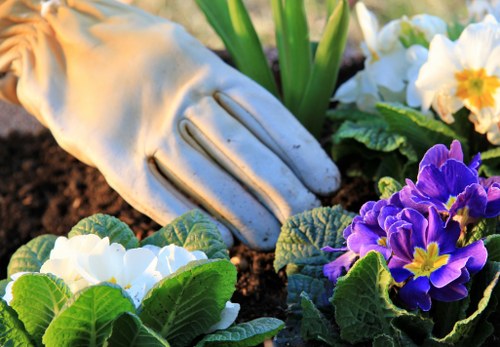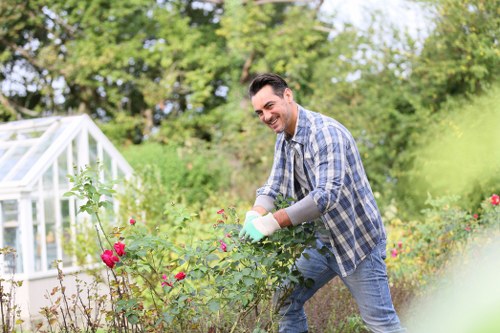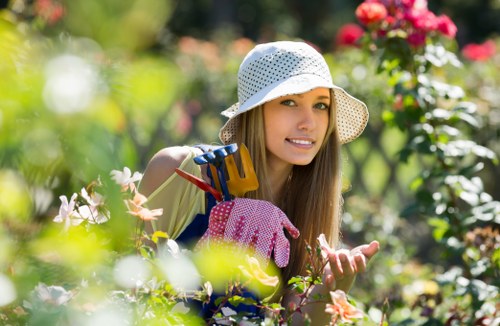Comprehensive Guide to Garden Maintenance in Plumstead

Maintaining a beautiful garden in Plumstead requires a blend of dedication, knowledge, and the right resources. Whether you're a seasoned gardener or a novice, understanding the unique aspects of garden care in this specific locale can make all the difference. In this article, we will delve into essential garden maintenance practices tailored for Plumstead's climate and soil conditions.
Plumstead's temperate climate offers a conducive environment for a variety of plants. However, local factors such as soil type, rainfall patterns, and seasonal changes play a significant role in garden health. Proper maintenance ensures that your garden not only survives but thrives, providing a serene and vibrant outdoor space.
One of the first steps in effective garden maintenance is understanding the specific needs of your plants. Different species require varying levels of water, sunlight, and nutrients. By tailoring your care routine to meet these needs, you can foster a more resilient and flourishing garden.

Essential Garden Maintenance Tasks
Regular garden maintenance involves several key tasks that, when performed consistently, keep your garden in top shape. These tasks include:
- Pruning: Removing dead or overgrown branches to promote healthy growth.
- Weeding: Keeping weeds at bay to prevent them from competing with your plants for resources.
- Watering: Ensuring plants receive adequate moisture, especially during dry spells.
- Fertilizing: Providing essential nutrients to support plant growth and vitality.
- Pest Control: Managing pests to protect your plants from damage.
Each of these tasks plays a pivotal role in maintaining the overall health and appearance of your garden. Neglecting any of them can lead to a decline in plant health and garden aesthetics.
In addition to these routine tasks, seasonal maintenance is crucial. Adjusting your care strategies based on the time of year helps in preparing your garden for upcoming changes and challenges.

Seasonal Garden Maintenance in Plumstead
Seasonal changes dictate specific maintenance activities to keep your garden resilient throughout the year. Here's a breakdown of essential tasks for each season:
Spring
Spring is a time of renewal and growth. Begin by clearing any debris that accumulated over the winter months. Prune dead branches and prepare your beds for new planting. It's also an ideal time to fertilize your plants, giving them the nutrients they need for a productive growing season.
Summer
During the hot summer months, focus on regular watering and mulching to retain soil moisture and regulate temperature. Keep an eye out for pests and diseases, addressing them promptly to prevent infestations. Deadheading spent flowers encourages more blooms and maintains the garden's appearance.
Autumn
As temperatures drop, begin preparing your garden for the winter. Remove annual plants, rake fallen leaves, and consider planting bulbs that will bloom in the spring. This is also a good time to compost garden waste, enriching your soil for future growth.
Winter
Winter maintenance involves protecting your garden from frost and harsh weather. Mulch perennials, cover sensitive plants, and plan for any new additions in the upcoming year. While growth slows, ensuring your garden is well-prepared will lead to a thriving space in spring.

Soil Health and Fertilization
Healthy soil is the foundation of a vibrant garden. Conducting a soil test can provide insights into its pH levels and nutrient content, allowing you to amend it accordingly. Incorporating organic matter such as compost can improve soil structure, enhance fertility, and promote beneficial microbial activity.
Fertilization should be tailored to the specific needs of your plants. Over-fertilizing can lead to excessive growth and vulnerability to pests, while under-fertilizing may result in poor plant health. Using slow-release fertilizers can provide a steady supply of nutrients, reducing the risk of nutrient burn.
Additionally, practicing crop rotation and using cover crops can prevent soil depletion and reduce the incidence of soil-borne diseases. These practices contribute to long-term soil health, ensuring sustained garden productivity.
Watering Strategies
Effective watering is crucial for plant health, especially during dry periods. Implementing a consistent watering schedule helps plants establish strong root systems. Drip irrigation systems can deliver water directly to the plant roots, minimizing evaporation and conserving water.
Mulching around plants not only retains moisture but also suppresses weeds and regulates soil temperature. It's important to water in the early morning or late evening to reduce water loss and prevent the spread of fungal diseases.
Monitoring soil moisture levels and adjusting your watering practices based on weather conditions ensures that your plants receive the optimal amount of water they need to thrive.

Pest and Disease Management
Maintaining a healthy garden involves vigilant pest and disease management. Regularly inspecting your plants for signs of distress can help in early detection and treatment. Integrated Pest Management (IPM) strategies combine biological, cultural, and chemical methods to control pests with minimal environmental impact.
- Biological Control: Introducing natural predators to manage pest populations.
- Cultural Practices: Rotating crops and selecting pest-resistant plant varieties.
- Chemical Control: Using pesticides judiciously and following best practices to minimize harm.
Preventative measures, such as maintaining plant health and reducing stress, can make your garden less susceptible to pests and diseases. Additionally, fostering biodiversity by planting a variety of species can naturally deter pests and create a more balanced ecosystem.
In cases of severe infestations or disease outbreaks, consulting with a professional garden maintenance service in Plumstead can provide effective solutions tailored to your specific needs.
Pruning and Trimming
Regular pruning and trimming are essential for shaping plants, promoting healthy growth, and preventing overcrowding. Removing dead or diseased branches improves air circulation and reduces the risk of infections. It's important to use the right tools and techniques to avoid damaging your plants.
Different plants have specific pruning requirements. For instance, flowering shrubs may need pruning after blooming, while fruit trees might require annual pruning to enhance fruit production. Understanding the growth patterns of your plants ensures that pruning contributes positively to their overall health and appearance.
Incorporating pruning into your regular maintenance routine keeps your garden aesthetically pleasing and encourages robust plant development.
Choosing the Right Plants for Plumstead Gardens
Selecting plants that are well-suited to Plumstead's climate and soil conditions is fundamental to successful garden maintenance. Native plants often require less maintenance and are more resilient against local pests and diseases. Additionally, they contribute to the biodiversity of the area, supporting local wildlife.
Consider incorporating a mix of perennials, annuals, shrubs, and trees to add variety and structure to your garden. Perennials provide sustained beauty with their recurring blooms, while annuals offer vibrant colors and flexibility in design. Shrubs and trees can act as focal points and provide shade, enhancing the garden's functionality.
When choosing plants, take into account factors such as sunlight requirements, water needs, and growth habits. Grouping plants with similar needs together can streamline maintenance tasks and create harmonious garden zones.
Hardscaping Elements
Incorporating hardscaping elements like pathways, patios, and garden structures adds functionality and aesthetic appeal to your garden. These features not only enhance the visual interest but also provide practical benefits, such as improved accessibility and organization.
Choosing materials that complement your garden's style and Plumstead's local architecture can create a cohesive and inviting outdoor space. Additionally, integrating seating areas and decorative features encourages relaxation and enjoyment of your garden.
Properly maintained hardscaping elements contribute to the overall health of your garden by reducing soil erosion, managing water flow, and providing habitats for beneficial organisms.
Mulching and Composting
Mulching is a vital practice in garden maintenance that offers multiple benefits. It helps retain soil moisture, suppresses weed growth, and regulates soil temperature. Organic mulches, such as bark, straw, and compost, also enrich the soil as they decompose, providing essential nutrients to your plants.
Implementing a regular mulching schedule can significantly reduce the time and effort required for garden upkeep. It also enhances the aesthetic appeal of your garden by giving it a neat and finished look.
Composting Techniques
Composting transforms organic waste into nutrient-rich soil amendments, promoting sustainable garden practices. By composting kitchen scraps, garden waste, and fallen leaves, you can reduce waste and improve soil fertility. A well-maintained compost pile requires the right balance of green and brown materials, adequate moisture, and regular turning to facilitate decomposition.
Utilizing compost in your garden enhances soil structure, increases microbial activity, and provides a steady supply of nutrients, reducing the need for chemical fertilizers. This practice fosters a healthy and thriving garden ecosystem.
Integrating mulching and composting into your garden maintenance routine supports environmental sustainability and contributes to the long-term health of your garden.
Professional Garden Maintenance Services in Plumstead
While DIY garden maintenance can be fulfilling, enlisting the help of professional garden maintenance services in Plumstead ensures that your garden receives expert care tailored to its specific needs. Professionals bring a wealth of knowledge, experience, and specialized tools that can enhance the health and beauty of your garden.
- Customized Maintenance Plans: Professionals assess your garden and develop tailored maintenance schedules that address its unique requirements.
- Expert Knowledge: Understanding local climate and soil conditions allows professionals to make informed decisions about plant care.
- Time Efficiency: Hiring professionals saves you time, allowing you to enjoy your garden without the stress of upkeep.
- Comprehensive Services: From pruning and fertilizing to pest control and landscaping, professionals offer a wide range of services to keep your garden in optimal condition.
Investing in professional garden maintenance services can transform your outdoor space into a lush and inviting sanctuary, free from the common challenges faced by DIY gardeners.
Whether you're looking to start a new garden or revitalize an existing one, professional services provide the expertise and support needed to achieve your gardening goals.
Choosing the Right Service Provider
Selecting a reputable garden maintenance service in Plumstead involves considering factors such as their experience, range of services, customer reviews, and pricing. It's essential to choose a provider that aligns with your vision and can deliver consistent, high-quality results.
Engaging with local gardeners and seeking recommendations can help identify reliable service providers. Additionally, scheduling consultations allows you to discuss your specific needs and gauge the professionalism and expertise of the service provider.
A well-chosen garden maintenance partner can make a significant difference in the health and beauty of your garden, providing peace of mind and a thriving outdoor environment.
Sustainable Garden Practices
Adopting sustainable practices in your garden maintenance not only benefits the environment but also promotes the long-term health of your garden. Sustainable gardening focuses on minimizing resource use, reducing waste, and enhancing biodiversity.
- Water Conservation: Implementing efficient watering systems and drought-resistant plants reduces water usage.
- Organic Gardening: Using organic fertilizers and pest control methods avoids harmful chemicals, fostering a healthier ecosystem.
- Biodiversity: Planting a variety of species attracts beneficial insects and wildlife, enhancing the resilience of your garden.
- Composting: Recycling organic waste into compost enriches the soil and reduces landfill contributions.
Incorporating these practices into your garden maintenance routine contributes to a sustainable and thriving garden, aligning with environmental stewardship and personal well-being.
Eco-Friendly Tools and Techniques
Using eco-friendly tools and techniques further enhances sustainable garden maintenance. Hand tools, solar-powered equipment, and biodegradable materials reduce your garden's carbon footprint and environmental impact.
Additionally, embracing natural pest control methods and integrated pest management minimizes the reliance on chemical interventions, promoting a healthier and more balanced garden ecosystem.
Sustainable practices not only preserve the environment but also create a harmonious and resilient garden that can adapt to changing conditions and challenges.
Energy Efficient Landscaping
Energy-efficient landscaping involves designing your garden to maximize natural resources and reduce energy consumption. Strategic placement of plants can provide shade and windbreaks, reducing the need for artificial heating and cooling. Utilizing rainwater harvesting systems for irrigation further conserves water and supports sustainable practices.
Incorporating native plants and perennials reduces maintenance requirements and supports local wildlife, creating a self-sustaining garden that thrives with minimal intervention.
By prioritizing energy efficiency and sustainability, your garden can become a model of environmental responsibility and beauty.
Enhancing Garden Aesthetics
Aesthetics play a crucial role in garden maintenance, contributing to the overall ambiance and appeal of your outdoor space. Thoughtful design elements, plant selection, and color coordination create a visually pleasing and harmonious environment.
- Plant Selection: Choosing plants with complementary colors and varying textures adds depth and interest to your garden.
- Seasonal Blooms: Incorporating plants that bloom at different times ensures year-round color and vibrancy.
- Garden Structures: Features like pergolas, arbors, and fountains add focal points and enhance the garden's visual appeal.
Regularly updating and refreshing your garden's design keeps it dynamic and engaging. Incorporating new plant varieties, decorative elements, and innovative landscaping techniques can transform your garden into a personal oasis.
Lighting and Decorations
Outdoor lighting enhances the beauty and functionality of your garden, allowing you to enjoy it even after dark. Strategically placed lights highlight key features, create ambiance, and improve safety by illuminating pathways and entrances.
Decorative elements such as sculptures, garden ornaments, and water features add personality and charm to your garden. These elements reflect your personal style and create a unique and inviting space for relaxation and entertainment.
Thoughtful incorporation of lighting and decorations elevates the overall aesthetic of your garden, making it a delightful space to enjoy throughout the day and night.
Color Schemes and Plant Arrangement
Choosing a harmonious color scheme enhances the visual coherence of your garden. Coordinating plant colors, foliage, and blooms creates a unified and attractive appearance. Experimenting with contrasting colors and varying plant heights adds dimension and interest.
Arranging plants in groups based on their needs and characteristics ensures easy maintenance and promotes healthy growth. Creating garden zones with specific themes or plant types adds structure and organization to your outdoor space.
By thoughtfully planning your garden's color schemes and plant arrangements, you can craft a visually stunning and well-maintained garden that reflects your aesthetic preferences and gardening expertise.
Tools and Equipment for Effective Garden Maintenance
Having the right tools and equipment is essential for efficient and effective garden maintenance. Quality tools not only make tasks easier but also contribute to the overall health and appearance of your garden.
- Pruning Shears: Essential for trimming and shaping plants.
- Garden Fork: Useful for aerating soil and turning compost.
- Hose with Adjustable Nozzle: Provides flexibility in watering plants.
- Wheelbarrow: Helps in transporting soil, plants, and tools.
- Lawn Mower: Keeps your lawn neat and well-maintained.
Investing in high-quality, durable tools reduces maintenance time and effort, allowing you to focus on creating and enjoying your garden. Regularly cleaning and maintaining your tools ensures their longevity and performance.
Storage Solutions
Proper storage of garden tools and equipment keeps your workspace organized and extends the life of your tools. Utilizing tool sheds, storage benches, and wall-mounted racks helps in efficiently organizing your garden essentials.
Keeping tools dry and protected from the elements prevents rust and damage, ensuring that they remain functional and ready for use when needed.
Implementing effective storage solutions promotes a tidy and efficient garden maintenance routine, enhancing both productivity and enjoyment.
Innovative Gardening Technologies
Embracing innovative gardening technologies can streamline maintenance tasks and improve garden health. Smart irrigation systems, weather monitoring tools, and automated lighting enhance the functionality and efficiency of your garden.
Integrating technology with traditional gardening practices provides greater control and precision, allowing you to optimize care routines and achieve optimal results.
Staying updated with the latest gardening tools and technologies ensures that your garden maintenance remains effective and enjoyable.
Creating a Maintenance Schedule
Developing a structured maintenance schedule ensures that all aspects of garden care are addressed systematically. A well-planned schedule helps in balancing tasks throughout the year, preventing burnout and promoting consistent garden health.
- Daily Tasks: Light watering, monitoring plant health.
- Weekly Tasks: Weeding, pruning, and checking for pests.
- Monthly Tasks: Fertilizing, deep cleaning garden tools.
- Seasonal Tasks: Preparing for upcoming seasons, major pruning, and soil amendments.
Utilizing a calendar or gardening app can help in tracking and reminding you of essential tasks, ensuring nothing is overlooked. Assigning specific tasks to particular days or weeks distributes the workload evenly and maintains garden vitality.
Adapting to Changes
Flexibility in your maintenance schedule allows you to adapt to unexpected changes such as weather fluctuations or plant health issues. Being proactive and responsive ensures that your garden remains resilient and continues to flourish despite challenges.
Reviewing and adjusting your maintenance plan periodically helps in aligning it with the evolving needs of your garden, fostering sustained growth and aesthetics.
Documentation and Record-Keeping
Maintaining records of your garden's progress, maintenance activities, and any issues encountered facilitates better management and decision-making. Documenting fertilization schedules, planting dates, and pest control measures provides valuable insights for future planning.
Analyzing past records helps in identifying successful strategies and areas needing improvement, enhancing your overall garden maintenance approach.
Effective documentation supports a more organized and informed gardening practice, contributing to the long-term success of your garden.
Conclusion: Achieving a Thriving Garden in Plumstead
Successful garden maintenance in Plumstead hinges on a combination of regular upkeep, understanding local conditions, and implementing sustainable practices. By adhering to a structured maintenance routine and leveraging professional services when needed, you can cultivate a lush and vibrant garden that enhances your outdoor living experience.
Embrace the beauty of Plumstead's natural environment by nurturing a garden that reflects your personal style and commitment to sustainability. With dedication and the right strategies, your garden can become a testament to the harmony between nature and meticulous care.
Ready to transform your garden? Contact us today to book your garden maintenance service and enjoy a flourishing outdoor space all year round.

